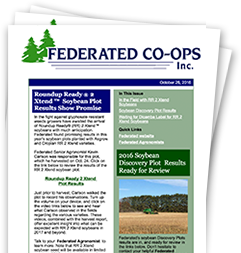Late Rains Make Way for Early Scouting

With the long stretch of dry weather that preceded recent rains, scouting fields and monitoring weed growth is critical. In much of Federated’s service areas, the pre-emerge herbicides had not been activated by rain, giving the weeds a head start on growth before the “herbicide barrier” was in place, said Kevin Carlson, Federated’s agronomy sales manager.
Carlson pointed out that “scouting and monitoring soybeans from today forward is really important” to determine emergence, plant stands, effectiveness of pre-emerge weed control, and for timing post-emerge herbicide applications. (The Sirrus app can help with scouting – see related article.)
“There’s lots to do in the soybean fields,” said Carlson. Check the stand count today – after the rain – and then go back and check those once-dry areas to see if they’ve emerged.
Mike Slater, agronomy sales rep at Federated’s Isanti location, noted that it’s important to make sure stands are close to target planting populations – moreso for corn than soybeans with their ability to bush and branch out to fill in for missing plants.
The lack of early rainfall on top of the pre-emerge applications may have affected the herbicide performance to some degree or another, according to Carlson.
Slater said he’s seen “lots of weeds starting to pop and the sooner we get at them and lay a residual herbicide, the better set we’ll be when we spray later.”
“With the majority of the soybeans already in the ground and starting to emerge,” said Slater, preemergence options are “going out the window, but early post options should still be considered,” he said. Priority™ 8E (metolachlor) and BattleStar® (fomesafen) are two products Federated recommends for early post-emerge application.
Contact your Federated Agronomist with emergence, herbicide, and other crop management questions. And start scouting today.


